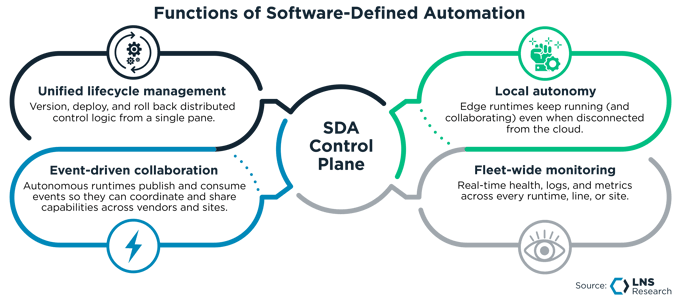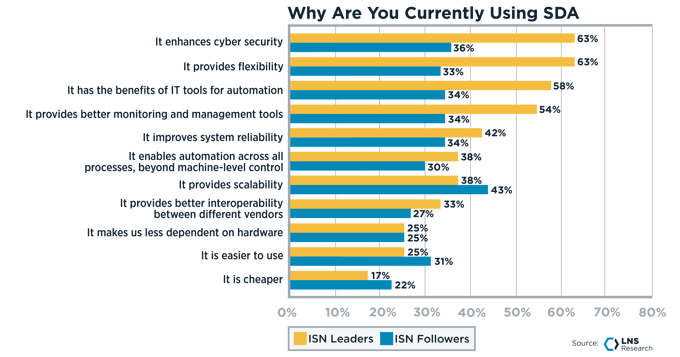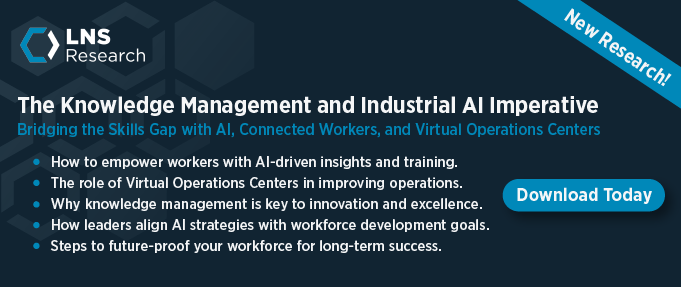Automation has been a cornerstone of production since the first industrial revolution. It took a huge leap with the invention of the Programmable Logic Controller (PLC) by Dick Morley in 1968. Automation is no longer restricted just to manufacturing; it is everywhere in businesses through the use of software applications, workflow tools, and Robotic Process Automation (RPA).
However, some of the traditional industrial automation tools have fallen behind the business automation tools, and it is time to shift gears to tools that are less hardware-dependent and easier to manage. Introducing Software-Defined Automation (SDA).
What is Software-Defined Automation?
LNS Research’s definition of SDA is:
Software-Defined Automation (SDA)
It is an innovative approach to industrial automation that separates control logic from hardware dependencies by using software to manage, orchestrate, and monitor industrial processes.
SDA leverages cloud technologies and DevOps practices to centrally manage operations while deploying distributed runtime systems for real-time control, where it makes the most sense.
These systems enable greater flexibility, scalability, and interoperability across multi-vendor environments.
There are five areas where SDA is making significant changes to the traditional industrial automation approach:

Figure 1 - Functions of Software-Defined Automation
Unified lifecycle management uses best practices from software development in industrial automation. It may be hard to believe, but many PLCs run programs without version control, automated testing, or deployment management. With these tools, SDA brings automation into the 21st century.
Local autonomy is a critical requirement for all automated systems. You want your brain (the controller) to be close to where your body (the equipment, sensors, actuators, and processes) is, and you want multiple local collaborating controllers to work independently from external systems. This does not mean that SDA cannot run in the cloud; it is just that you would run it there when there is a business case for it, such as orchestrating a supply chain.
Event-driven collaboration is a shift away from traditional industrial automation thinking. Almost all industrial automation systems have been scan-based, which guarantees time-determinism as everything is executed within a single scan. However, this approach is not very efficient and can cause unnecessary delays and complexity, so a new event-driven approach was chosen.
Fleet-wide monitoring ensures that the whole system is running as planned. You no longer need to drive to the plant to see if the PLC is running; you can now see this from your cell phone connected to the cloud.
The SDA Control Plane disconnects the hardware from the control logic.
Why do manufacturers want Software-Defined Automation?
You will often hear that industrial automation equipment is expensive, and you may think that using lower-priced commodity hardware is the biggest driver; however, nothing could be further from the truth. While it costs more than consumer electronics, automation systems provide significant value through their reliable operations. For most processes, the risk of a single hour of production downtime can be sufficient to justify the cost of a rugged PLC.
In a recent study, LNS Research uncovered that the biggest justification among leaders in the field for using SDA was cyber-security, flexibility, access to IT-like tools, and better monitoring and management tools. Followers were less likely to see the same benefits of SDA.
Figure 2 - Why are you using SDA?
The cost was the last item on the list, which is a surprise to many.
The Vendors that are Active in Software-Defined Automation
Most automation vendors have some functionality that is relevant for SDA (and the ones who don’t need to wake up), and a handful have a relatively strong offering or roadmap. If we divide the vendors into two categories, those that provide runtime services and those that provide industrial automation DevOps services, then the market landscape looks like this:
Runtime Services:
|
Vendor
|
Strengths
|
|
Schneider Electric
|
EcoStruxure Automation Expert (EAE): full separation of logic, uses IEC 61499, orchestration layer. UniversalAutomation.org.
|
|
Bosch Rexroth
|
ctrlX Automation: Linux-based, containerized runtimes, full orchestration APIs.
|
|
Phoenix Contact
|
PLCnext: open control platform, supports container deployment and monitoring.
|
|
Software-Defined Automation (partially)
|
Cloud-based runtime orchestration, control abstraction, and a strong management layer. No control plane or runtime engine.
|
|
Siemens (partially)
|
Industrial Operations X and Industrial Edge: orchestration vision, but the runtime is still Siemens-specific.
|
|
Beckhoff (partially)
|
TwinCAT can be managed via scripting/tools, but not full orchestration separation by default.
|
|
CODESYS (partially)
|
Widely adopted Soft-PLC platform; supports modular logic and deployment per device. Central management is via an Automation Server; there is no dynamic, built-in multi-device orchestration.
|
|
UniversalAutomation.org (non-vendor)
|
Open IEC 61499 runtime standard and shared source project, enabling multi-vendor SDA interoperability.
|
Runtime services include the control plane, runtime management, orchestration, and monitoring. The capabilities within each category differ. Notably, the company Software-Defined Automation does not have its own control plane, so all functionality is there to support third-party runtimes.
Industrial Automation DevOps:
|
Vendor
|
Strengths
|
|
Copia Automation
|
DevOps tooling purpose-built for industrial control engineers; Git, CI/CD, reviews
|
|
Software Defined Automation
|
Native DevOps mindset — cloud deployment, Git-like workflows
|
|
Schneider Electric
|
EAE with tooling evolving toward CI/CD
|
|
Siemens
|
TIA Portal with GitHub integration; Industrial Operations X introduces collaborative workflows
|
|
Rockwell Automation
|
FactoryTalk Design Studio + Design Hub = shift to SaaS DevOps model
|
|
Beckhoff
|
TwinCAT/Bash/PowerShell scripting for CI/CD, limited DevOps ecosystem natively
|
Many of the vendors in the industrial automation DevOps space are still evolving their capabilities. They have all shown a strong interest in SDA and have therefore been included.
Recommendations
The Software-Defined Automation approach is showing promise in the market. Several major vendors are investing in SDA, and we believe that more will follow.
If you are looking for the benefits of SDA, then we recommend that you do the following:
-
-
-
Start by documenting your business objectives and hard requirements. Map these to SDA and decide whether to proceed.
-
Educate yourself about SDA, standards like IEC 61499, and DevOps.
-
Contact your local system integrators and determine if they are SDA competent. If not, encourage them to acquire this knowledge.
-
Contact the tech vendors in this space and familiarize yourself with their offerings.
-
Explore membership in organizations such as the Open Process Automation Forum (OPAF) and UniversalAutomation.org.
Further Reading
LNS Research will continue to provide research on Software-Defined Automation. Until then, we recommend the following relevant research:
